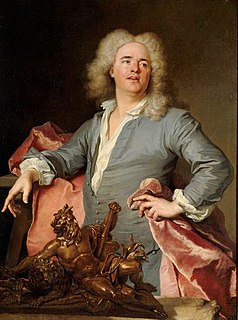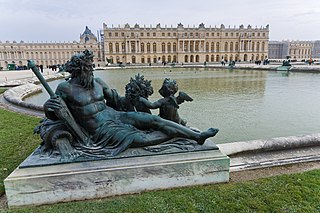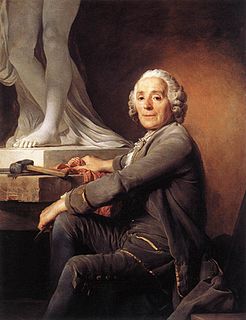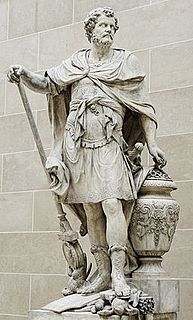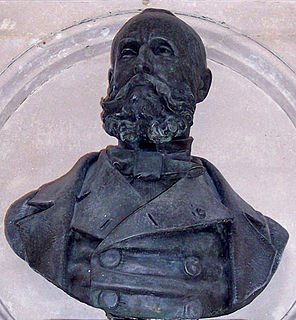
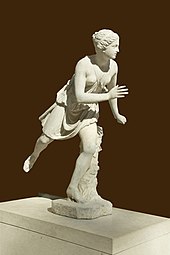
Pierre Lepautre (4 March 1659 – 22 January 1744) [1] was a French sculptor, a member [2] of a prolific family of artists in many media, who were active in the 17th and 18th centuries. He was born and died in Paris.

Paris is the capital and most populous city of France, with an area of 105 square kilometres and an official estimated population of 2,140,526 residents as of 1 January 2019. Since the 17th century, Paris has been one of Europe's major centres of finance, diplomacy, commerce, fashion, science, and the arts.
He won the Prix de Rome, for study at the French Academy in Rome, where he was a pensionnaire' from 1683 to 1701. While in Rome he sent back to France a number of sculptures demonstrating his skill, among which were the Faune au chevreau of 1685, which went to ornament the gardens at Château de Marly. [3] Lepautre returned to Paris in 1701. His Atalante (1704) was also destined for Marly. From 1705 to 1710, he was occupied with decorative bas-reliefs and sculptures for the royal chapel of Versailles, under the artistic supervision of Jules Hardouin-Mansart: his are the colossal statues of Saint Ambrose and Saint Gregory. [4]

The Prix de Rome or Grand Prix de Rome was a French scholarship for arts students, initially for painters and sculptors, that was established in 1663 during the reign of Louis XIV of France. Winners were awarded a bursary that allowed them to stay in Rome for three to five years at the expense of the state. The prize was extended to architecture in 1720, music in 1803, and engraving in 1804. The prestigious award was abolished in 1968 by André Malraux, the Minister of Culture.
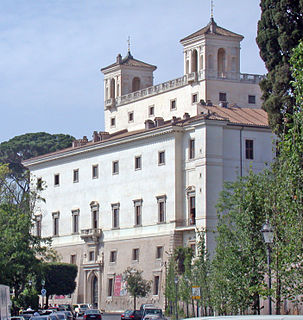
The French Academy in Rome is an Academy located in the Villa Medici, within the Villa Borghese, on the Pincio in Rome, Italy.

The Château de Marly was a relatively small French royal residence located in what has become Marly-le-Roi, the commune that existed at the edge of the royal park. The town that originally grew up to service the château is now a bedroom community for Paris.
A retable in the form of a monumental gateway in the église de Saint-Eustache, Paris, illustrates the assumption of Saint Agnes.

A retable is a structure or element placed either on or immediately behind and above the altar or communion table of a church. At the minimum it may be a simple shelf for candles behind an altar, but it can also be a large and elaborate structure. A retable which incorporates sculptures or painting is often referred to as an altarpiece.

His completion of the over-lifesize group of Arria et Pœtus (finished 1695) after the design begun by Jean-Baptiste Théodon proceeded too slowly [5] and Énée portant son père Anchise suivi d'Ascagne (signed and dated 1716), after François Girardon [6] demonstrated his facility and fidelity as an executant. The sculpture of Aeneas carrying Anchises was begun in Rome, where Lepautre made numerous terracotta bozzetti for it. [7] The sculpture gained renown for Lepautre: bronze reductions of it were made for collectors. [8] The 19th-century classicizing sculptor David d'Angers had one of Lepautre's designs for it, which was given by his widow to the museum in his native city. [9]

Jean-Baptiste Théodon (1645—1713) was a French sculptor.

François Girardon was a French sculptor of the Style Louis XIV or French Baroque, best known for his statues and busts of Louis XIV and for his statuary in the gardens of the Palace of Versailles.
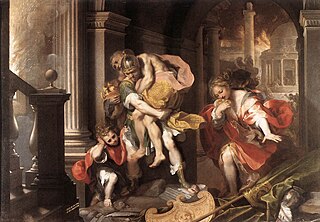
In Greco-Roman mythology, Aeneas was a Trojan hero, the son of the prince Anchises and the goddess Aphrodite (Venus). His father was a first cousin of King Priam of Troy, making Aeneas a second cousin to Priam's children. He is a character in Greek mythology and is mentioned in Homer's Iliad. Aeneas receives full treatment in Roman mythology, most extensively in Virgil's Aeneid, where he is cast as an ancestor of Romulus and Remus. He became the first true hero of Rome. Snorri Sturluson identifies him with the Norse Æsir Vidarr.
Pierre Lepautre preferred to become a member of the modest artists' Académie de Saint-Luc, for which he held a lifetime post as Rector, rather than try for the more prestigious Académie royale de peinture et de sculpture.
The Académie de Saint-Luc was a painters' guild set up in Paris in 1391, and dissolved in 1777. It was set up by the Provost of Paris, along the lines of the Guilds of Saint Luke in the rest of Europe.

The Académie Royale de Peinture et de Sculpture, Paris, was the premier art institution in France in the eighteenth century.

